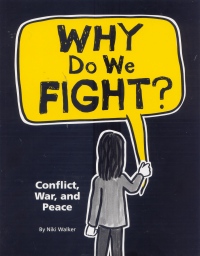| ________________
CM . . .
. Volume XX Number 12. . . .November 22, 2013
excerpt:
Designed to introduce the complex topic of world conflict to preteens, Why Do We Fight? employs a conversational tone and comparisons between global conflicts and readers’ real-life experiences at home and at school in order to get the point across. The book begins with a definition of conflict and describes the most common reasons for two (or more) disputants to argue. Whether or not the conflict will be resolved peacefully is determined by a number of factors, not the least of which is the current existing relationship between the disputants. The source of the conflict is not always easy to determine, but the disagreement is usually about someone getting in the way of another’s wants or needs, perhaps tangible, such as resources, or intangible, such as freedom or equality. Remaining chapters cover such topics as civil unrest and people’s need to belong to a group; the factors involved in the likelihood of two factions solving an agreement diplomatically or with violence; peacekeeping and peace building efforts and the role of the United Nations; and encouraging readers to become more media literate so that they can look at the “big picture”, think critically, and distinguish bias and propaganda from facts when viewing or listening to news reports about global conflicts. Throughout the book there are real life examples of world conflicts, with particular emphasis on the recent war in Afghanistan and the history leading up to it, as well as brief information about people who promoted peace, such as Mahatma Gandhi, Nelson Mandela and Martin Luther King, Jr. As well, interspersed throughout the book are quotes from philosophers, government leaders and peace activists. Readers will also be introduced to a variety of terms, such as revolution, coup, regime, genocide, stereotyping, arbitration, mediation, sanctions, and zero-sum game (a term which refers to seeing a negotiation as a competition having only one winner), to name a few. Though the premise of the book is sound and the comparison of world conflicts and their resolution to the daily lives of the targeted audience members works, this book seems to be more of a teaching resource than a book that tweens would readily pick up. The graphics, font styles and design layout are attractive, but the black, grey and daffodil yellow colour scheme becomes monotonous and boring due to the book’s lack of illustrations (save for a few maps and rudimentary diagrams, all rendered in the same colour scheme as the rest of the book). A table of contents and an index are included. A useful tool for the classroom teacher, Why Do We Fight? will not only provide a springboard for lively group discussions, but it will also help middle school students to examine conflicts from several perspectives. Recommended. Gail Hamilton, a former teacher-librarian, lives in Winnipeg, MB.
To comment
on this title or this review, send mail to cm@umanitoba.ca.
Copyright © the Manitoba Library Association. Reproduction for personal
use is permitted only if this copyright notice is maintained. Any
other reproduction is prohibited without permission.
NEXT REVIEW |
TABLE OF CONTENTS FOR THIS ISSUE
- November 22, 2013.
AUTHORS |
TITLES |
MEDIA REVIEWS |
PROFILES |
BACK ISSUES |
SEARCH |
CMARCHIVE |
HOME |
